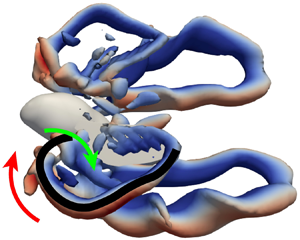Article contents
A CFD data-driven aerodynamic model for fast and precise prediction of flapping aerodynamics in various flight velocities
Published online by Cambridge University Press: 31 March 2021
Abstract

Precise prediction of unsteady flapping aerodynamics in insect flight is of potential importance in the analysis of maneuverability and flight control. While the quasi-steady model is a cheap while reasonable tool, accurate evaluation of unsteady dynamic effects in complex flight behaviours remains a challenge. Here we develop a computational fluid dynamics (CFD) data-driven aerodynamic model (CDAM), which is informed by high-fidelity CFD simulations using overset meshes to enable the precise and fast prediction of both cycle-averaged and transient aerodynamic force, torque and power with various flying motions and wing kinematics. The CDAM comprises a quasi-steady model for flapping wings and an aerodynamic model for a moving body. The least square method and a surrogate method are employed to achieve aerodynamic coefficient fitting through training using a CFD database. With comparison to CFD test data, the CDAM is validated to be capable of accurately evaluating the aerodynamic force, torque and power of a wing-body bumblebee model in various flight velocities. A genetic optimization algorithm embedded with CDAM is proposed to determine trimmed states for forward flight through adjusting wing kinematics, indicating that bumblebees likely fly in a minimized mass-specific aerodynamic power consumption. The CDAM is further applied to proportional-derivative-based longitudinal flight control of bumblebee hovering, with the control parameters optimized by Laplace transformation and the root locus method, which is implemented consistently in both CDAM and CFD environments. Our results demonstrate that CDAM provides a versatile tool to achieve fast and precise aerodynamical prediction for flying insects in various flight behaviours.
JFM classification
Information
- Type
- JFM Papers
- Information
- Copyright
- © The Author(s), 2021. Published by Cambridge University Press
References
REFERENCES
- 33
- Cited by


